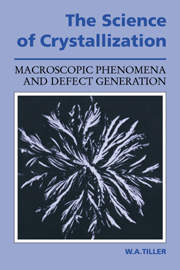Book contents
- Frontmatter
- Contents
- Preface
- Symbols
- 1 Introduction
- 2 Convection and heat transfer
- 3 Steady state solute partitioning
- 4 Macroscopic and microscopic solute redistribution
- 5 Morphological stability of interfaces
- 6 Dynamic interface morphologies
- 7 Physical defect generation during bulk crystal growth
- 8 Defect generation during thin film formation
- References
- Index
1 - Introduction
Published online by Cambridge University Press: 22 January 2010
- Frontmatter
- Contents
- Preface
- Symbols
- 1 Introduction
- 2 Convection and heat transfer
- 3 Steady state solute partitioning
- 4 Macroscopic and microscopic solute redistribution
- 5 Morphological stability of interfaces
- 6 Dynamic interface morphologies
- 7 Physical defect generation during bulk crystal growth
- 8 Defect generation during thin film formation
- References
- Index
Summary
Coupling equations
Crystallization is a many-variable, many-parameter interaction event in Nature and in technology and scientific understanding of this area feeds the very large application field illustrated in Fig. 1.1. For the territory lying within the scientific understanding box, it is necessary to treat the crystallization event as a dynamic system with many interacting parts or subsystems. These are illustrated in Fig. 1.2 for a typical case. The unique morphology and special phenomena associated with the crystallization event arise out of the conjunction of these subsystems interacting with each other in pairs, triplets, etc.
It is in the far-field domain of a growing crystal where the macroscopic or global thermodynamic state variables, (C, T, P, φ) = (C∞, T∞, P∞, φ∞) are fixed or changed dynamically according to some particular program (Ċ∞, Ṫ∞, Ṗ∞, ∞). However, it is mainly at the interface of the growing crystal that all the morphological, chemical segregation and embryonic physical defect phenomena arise in the crystallization event. Thus, scientific understanding of the overall process requires a description in terms of the thermodynamic state variables and their gradients at the growing interface; i.e., (Ci, Ti, Pi, φi) and (∇iC, ∇iT, ∇iP, ∇iφ). The connection between the interface conditions and the far-field conditions occurs via a set of partial differential equations and their boundary value constraints.
- Type
- Chapter
- Information
- The Science of CrystallizationMacroscopic Phenomena and Defect Generation, pp. 1 - 18Publisher: Cambridge University PressPrint publication year: 1992

